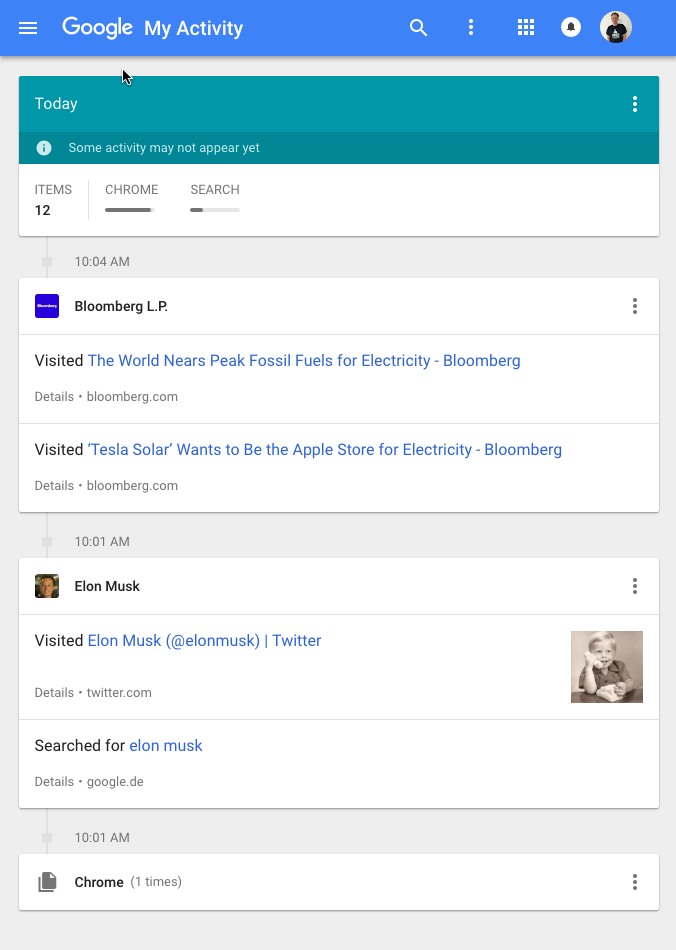There is growing evidence, that Google can identify and devalue unnatural links very well by using User Signals.
Already in 2014, we wrote about the fact that Google has the possibility to evaluate links by using data from the Chrome Browser. Using the User Signals on how often a link is actually clicked on by users, Google could asses the true value of a link. Unnatural links could be as easily exposed as links from websites, which have only been created in order to sell links, but which do not have any actual visitors due to missing added value.
Up until now, there concrete evidence has been missing to support the theory that Google Chrome Browser has been sending its user’s browsing habits to Google. Now, that evidence exists.
Google My Activity shows the browsing history
Google has introduced the new service “My Activity”. There, users can see which data Google has saved about them while using Google products.
Part of that data is the browsing history of the Google Chrome Browser. Therefore, Google receives extensive data, on how the user moves in the web.
The following screenshot shows for instance, that I have used the Google Chrome Browser today at 10:01. I sent a search query about “Elon Musk” on Google Search and through this way I visited Elon Musk’s Twitter page. There, I clicked on a link to an article on Bloomberg.com about Tesla and Solar City. At the end of this page, I clicked on another article. This too has been saved correctly on “My Activity”:

Google can report on every user as accurately on how often a certain page has been viewed and which links the user has followed.
Why are these data this important and which meaning do they have for link building and internal linking? The answer lies in the Google Patent “Ranking documents based on user behavior and/or feature data (US 8117209 B1)“, which has been registered on the 19th March, 2010 and published on the 14th February, 2012.
A link becomes more important as it gets more actual clicks
In this document Google describes a further development of the PageRank-Model. I will try to explain the underlying complex maths as easy as possible, so that everyone can follow. This section might be a bit harder to read, but it is worth it. Every SEO needs to have understood this model.
The PageRank Value can be understood as the probability that at this moment a surfer in the web is on a specific site. The more links lead to this site, and the more important the site is from which is being linked, the higher the probability that a surfer will be on that site. If there are many links as well as many links from important sites leading to a specific target page, then it has a high PageRank and therefore a high ranking advantage.
In the initial model, Google assumed a random surfer (Random Surfer Model). In simple terms, the random surfer moves through the web, by randomly clicking on one of the outbound links. The click-probability of each outbound link on a site is the same, since the random surfer chooses one of the links provided at random. Therefore, according to this model, all outbound links on a site pass on the same PageRank.
The patent „Ranking documents based on user behavior and/or feature data” describes a further development of this model. We no longer have a surfer that chooses a link at random, but consciously. Google calls this the Reasonable Surfer.
According to the Reasonable Surfer Model, links gain importance by being clicked on more frequently. Conversely, links that are rarely clicked on or not at all, loose importance and are weighted less, accordingly. In this patent, Google explains which links are being clicked on the most frequently. These can be links, which, for instance, can be found in the main content of the page, rather at the beginning of the content, highlighted in colour and underlined. These are clicked on more frequently, than, for instance, a link in a smaller font in the footer of the website. The more frequently a link gets clicked on, the stronger it will be weighted.
With the upgrade from the Random Surfer to the Reasonable Surfer, the prognosis of the probability that a surfer can be found on a specific site, has significantly improved.
Especially Google can use the new method to fight against unnatural links. A link, which does not get clicked on, does not pass on a PageRank and thus does not cause a ranking advantage.
Unnatural links are rarely clicked on
When links are explicitly used just to influence the PageRank of the target site, they violate Google’s Guidelines. If we have a look at which links Google describes as unnatural, then nearly all of these links have one point in common. Probably, they get rarely clicks from real users. For instance, these can be links, which are not visible, as links in the footer of a website, links on link-exchange-sites, links on low-quality sites, low-quality directories or bookmark site, press releases, signatures in forums or comments in guestbooks, etc. They rarely get clicks, since they are not relevant to the users, look like spam and/or because the linking site rarely has any real visitors.
With the Reasonable Surfer, Google has found a very elegant solution to devalue such links. If these links are rarely clicked on, then they have no influence on the ranking.
Google knows how often a link is clicked on
This method works even better, the more precisely Google manages to predict the actual number of clicks. This is when the Google Chrome Browser becomes relevant. Google Chrome Browser sends the browsing history to Google, as the data in My Activity shows. With this data, Google can create an exact movement profile between websites and calculate the importance of links.
The Chrome Browser possesses a market share of 57% on the Desktop throughout the world, according to Statcounter.com. Hence, more than half of worldwide internet usage is happening on a Chrome Browser. With that, it is possible to make very accurate statistical statements of each website. These data is significantly more valuable to Google than data from Google Analytics. Each site that does not use Analytics, would be a Black Box for Google. Chrome provides an extensive statistic to each website.
The user signals in the form of actual clicks on links will probably be hard to falsify through click robots in the long term as well. The data is assigned to user profiles, and Google can assess the trustworthiness of a user. My Activity also displays data on the location, on the usage of Gmail, the search, appliances used, Google Now, Google Documents and Tables, pageviews behind a login, and so on. Using this data, it should be easy to differentiate between a human and a robot.
Conclusion
For a long time we have suspected that Google can measure through the Chrome Browser how often a link gets actually clicked on to devalue an unnatural link accordingly. Now, the data in My Activity deliver the evidence, that the Chrome Browser really does send User Signals to Google. Every SEO should assume, that links which do not get clicked on, will not have any value for the ranking in the long term.
This applies even more if you look at the success Google has had in fighting against Link Spam in the previous years. The use of User Signals from the Google Chrome Browser is a very good explanation for that.
By Hanns Kronenberg

